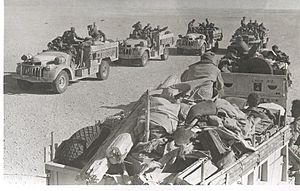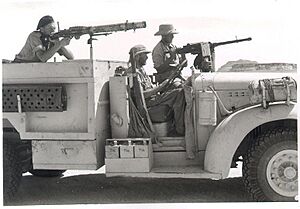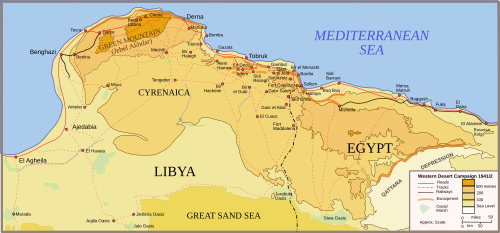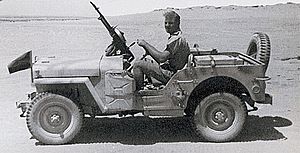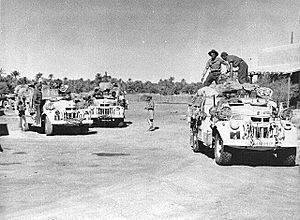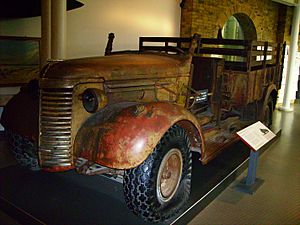Long Range Desert Group facts for kids
Quick facts for kids Long Range Desert Group |
|
|---|---|

LRDG badge depicting a scorpion within a wheel
|
|
| Active | July 1940 – August 1945 |
| Country | United Kingdom |
| Branch | British Army |
| Role | Reconnaissance Intelligence gathering Raiding operations |
| Size | Maximum 350 all ranks |
| Part of | Western Desert Force Eighth Army |
| Nickname(s) | Libyan Desert Taxi Service Pattuglia Fantasma (Italian: Ghost Patrol) |
| Motto(s) | Non Vi Sed Arte (Latin: Not by Strength, but by Guile) (unofficial) |
| Equipment | Chevrolet or Ford trucks, Willys Jeep |
| Engagements | Second World War |
| Disbanded | 1 August 1945 |
| Commanders | |
| Notable commanders |
Ralph Alger Bagnold Guy Lenox Prendergast John Richard Easonsmith David Lloyd Owen |
The Long Range Desert Group (LRDG) was a special unit of the British Army during the Second World War. Their main job was to explore and gather information deep behind enemy lines. They also carried out surprise attacks.
This group was first called the Long Range Patrol (LRP). It was started in Egypt in June 1940 by Major Ralph Alger Bagnold. Most of the first members were from New Zealand. Soon, volunteers from Southern Rhodesia and Britain joined. The unit then became known as the Long Range Desert Group (LRDG). At its largest, the LRDG had about 350 volunteers.
The LRDG was formed to go far behind Italian lines. They would secretly scout and collect important information. Sometimes, they also fought. Because they were experts at navigating the desert, they often guided other special units, like the Special Air Service. During the Desert Campaign (1940-1943), the LRDG vehicles were almost always behind Axis lines. One famous attack was Operation Caravan in September 1942. They attacked the town of Barce and its airfield. Their most important job was the 'Road Watch'. They secretly watched traffic on the main road from Tripoli to Benghazi. They sent this information to British Army Headquarters.
After the Axis forces gave up in Tunisia in May 1943, the LRDG moved to the eastern Mediterranean. They did missions in the Greek islands, Italy, and the Balkans. The LRDG was officially ended in August 1945, after the war in Europe finished.
Contents
How the LRDG Was Formed
Before the war, Major Ralph Alger Bagnold learned a lot about driving, fixing, and navigating vehicles in the desert. On June 23, 1940, he met General Archibald Wavell. Wavell was the commander in the Middle East Command in Alexandria. Bagnold explained his idea for a group that would do long-range scouting behind Italian lines in Libya.
General Wavell knew a lot about fighting in the desert. He liked Bagnold's idea and helped get the group the equipment they needed.
The unit, first called the No.1 Long Range Patrol Unit (LRP), started on July 3, 1940. Bagnold wanted strong, smart, and independent men. They needed to be able to live and fight alone in the Libyan desert. He thought New Zealand farmers would be perfect. Over half of the 2nd New Zealand Division volunteered! Two officers and 85 other soldiers were chosen. They trained in desert survival, driving, and navigation. They also learned radio communication and how to use explosives.
The LRP first had three units, called patrols. Later, they got more men and added a Heavy Section. In November 1940, the LRP became the "Long Range Desert Group" (LRDG). British and Southern Rhodesian volunteers joined the New Zealanders. A patrol usually had two officers and 28 other soldiers. They used Canadian Military Pattern (CMP) Ford trucks and Chevrolet trucks. In March 1941, patrols were split into smaller half-patrols. Each half-patrol had an officer and 15–18 men in five or six vehicles. Every patrol included a medical helper, a navigator, a radio operator, and a vehicle mechanic. Each of these specialists had a truck set up for their role.
LRDG Patrols and Their Structure
The first Long Range Patrol had a 15-man headquarters led by Bagnold. It had three main sub-units: 'R' Patrol, 'T' Patrol, and 'W' Patrol. 'T' and 'W' Patrols were for fighting, while 'R' Patrol was for support.
In November 1940, the LRDG grew to six patrols: 'T', 'W', 'R', 'G', 'S', and 'Y'. 'G' Patrol was made of men from the Brigade of Guards. 'Y' Patrol was made of men from the Yeomanry regiments. By June 1941, the LRDG was organized into two main groups, called squadrons. 'A' Squadron had the New Zealand and Rhodesian patrols ('S', 'T', 'R'). 'B' Squadron had the British patrols ('G', 'H', 'Y'). There was also a Headquarters Section, plus sections for signals, surveying, and vehicle repair. A Heavy section used large trucks to carry supplies and set up hidden supply points. They even had a small Air Section with two planes to move important people and help wounded soldiers.
In August 1941, an artillery unit was formed to attack Italian forts. They tried using a large QF 4.5-inch howitzer gun on a truck. They successfully attacked a fort at El Gtafia. However, this experiment ended because the truck had to be left behind.
Expanding the Squadrons
In October 1941, the LRDG grew to 10 patrols. They simply split the existing patrols into two half-patrols. The New Zealanders formed A Squadron. The British and Rhodesians formed B Squadron.
In December 1941, the Indian Long Range Squadron joined. These soldiers were volunteers from Indian cavalry regiments. Their patrols were named 'I1', 'I2', 'I3', and 'I4'. A special unit called "Popski's Private Army" also joined the LRDG for a short time in December 1942.
Each patrol had its own special markings on their vehicles. The New Zealand 'R' Patrol used a green Hei-tiki (a Māori symbol) on the right side of the bonnet. On the left, they had a Māori place name starting with 'R'. The 'T' Patrol vehicles had a black Kiwi bird and a Māori name starting with 'Te'. The British 'G' Patrol vehicles usually had no special markings. The 'Y' Patrol vehicles had names of famous places or characters from "Three Musketeers" books. The Rhodesian 'S' Patrol vehicles had names connected to Rhodesia. By 1943, they stopped naming new vehicles.
Their Special Gear
Vehicles for the Desert
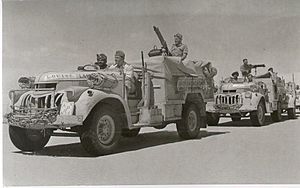
The LRDG mainly used two wheel drive vehicles. They were lighter and used less fuel. All unnecessary parts like doors, windscreens, and roofs were removed. They added bigger radiators, special cooling systems, and strong leaf springs for rough ground. They also used wide, low-pressure desert tires, sand mats, and special map holders. A unique sun compass, designed by Bagnold, helped them navigate. Radio trucks had special areas built in for their equipment.
At first, they used Ford and Chevrolet trucks. From March 1941, they used Canadian Military Pattern Ford trucks. These were heavier and used more fuel. So, from March 1942, they got 200 special Canadian Chevrolet trucks. From July 1942, Willys jeeps were given to patrol commanders and sergeants.
Weapons They Used

The LRDG vehicles were armed with many different guns. They started with Lewis machine guns, Boys anti-tank rifles, and a Bofors 37 mm anti-tank gun. By December 1940, they had added Vickers Medium Mk. I machine guns. Another powerful gun was the heavy Vickers .50 machine gun, often mounted at the back of the vehicle. Every LRDG vehicle had at least one gun. They had many places to mount guns, but usually only two or three were used at a time.
The LRDG also used extra aircraft guns from the Royal Air Force (RAF). These guns could fire very fast. The Vickers K machine gun was popular, sometimes used in pairs. From mid-1941, they got .303 Browning Mk II's from the RAF. These were also mounted in pairs and could fire 2,400 rounds per minute! In March 1942, some trucks were changed to carry captured 20 mm Breda Model 35 guns. These replaced the Bofors 37 mm guns. By September 1942, the .50 Browning AN/M2 heavy machine gun started to replace other machine guns and anti-tank rifles.
The soldiers carried standard British weapons like the Short Magazine Lee–Enfield (SMLE) No.1 Mk III* rifle. They also used Thompson submachine guns and various pistols. They used different types of hand grenades, including the Mills bomb. Each truck had a rifle attachment to fire rifle grenades. The LRDG also used land mines and special explosives called Lewes bombs to destroy enemy aircraft and vehicles. They even used "sticky bombs" to destroy enemy vehicles.
They also used captured German and Italian weapons. These included pistols like the Beretta M 1934 and Luger P08. They also used German MP40 submachine guns and MG34, MG42 machine guns. Italian Breda M37 and Breda M38 machine guns were also used.
Staying in Touch
Most of the LRDG radio operators were from the Royal Corps of Signals. These men were very good at communications. They could fix their equipment without outside help. Only three times did a broken radio stop a patrol from talking to headquarters. All LRDG patrols had one vehicle with a Wireless Set No. 11 and a Philips radio receiver. The No. 11 Set was made for tanks. It could send and receive messages over 3 to 20 miles.
The LRDG used Morse code for all messages. They could send messages over very long distances. They used a dipole antenna system attached to a 6.3-foot rod antenna on the truck. This worked up to 500 miles. For longer distances, they used a Windom dipole system. This was hung between two 17-foot tall poles. The Windom system took time to set up, so it was only used in safe areas. The Philips receiver helped them check Greenwich Mean Time (GMT), which was important for navigation.
When moving, the lead vehicles of patrol commanders and sergeants flew small flags. This helped control patrol movements. They used a simple semaphore flag system or hand signals.
Finding Their Way
All LRDG trucks had the Bagnold sun compass. Some also had a P8 Tank Compass. Each patrol had a navigator who rode in the second truck. He used a theodolite and astronomical tables to plot star sightings. They also used maps. Watches were set each evening using the GMT time check. A big problem early on was the lack of good maps for Libya. Patrols had to survey and make their own maps of each route they took. In July 1941, the Survey Section was created just for this job.
Amazing Desert Missions
The LRDG operated in the Western Desert between 1940 and 1943. This huge area stretched about 930 miles south from the Mediterranean Sea. It also went about 1200 miles from the Nile valley in the east to the mountains of Tunisia in the west. There were no paved roads, only small tracks. Daytime temperatures could be extremely hot, and at night they could drop below freezing. The only water was in small oases, where plants also grew. While most of the Eighth Army fought along the coast, the LRDG operated deep inland.
The first LRP patrol started during the Italian invasion of Egypt. 'W' Patrol set out on September 15, 1940, to scout Kufra and Uweinat. They found no Italians. Instead, they attacked fuel dumps, aircraft, and an Italian supply convoy. 'T' Patrol explored the main route between Kufra and Uweinat. They then met 'W' Patrol. Both units returned to base, having captured two Italian trucks and mail. The Italians reacted by sending more troops to garrison the area.
On December 27, 1940, 'G' and 'T' Patrols left Cairo. They crossed the desert to northwest of Kufra. They met with Free French forces from Chad. On January 11, they attacked the Italian fort at Murzuk together. The fort stayed in Italian hands, but the nearby airfield was destroyed. The units then pulled back south.
On January 31, they were attacked by the Compagnia Autosahariana di Cufra. This was an Italian unit similar to the LRDG. This happened in the Gebel Sherif valley. The LRDG lost one man killed and three captured, including Major Clayton. Three trucks were destroyed. Four LRDG members escaped. They walked 200 miles to safety in ten days with almost no food or water. The patrol returned to Egypt on February 9. They had traveled about 4500 miles. Major Clayton was awarded the Distinguished Service Order for his bravery.
After Operation Compass pushed the Italians out of Cyrenaica, the LRDG moved from Cairo to Kufra. The LRDG also grew with 'Y' and 'S' Patrols joining. When the German Afrika Korps attacked in April 1941, the LRDG was ordered to help defend the Kufra area.
The LRDG air link was created by Major Guy Lenox Prendergast. He saw how useful planes were for scouting, connecting units, and moving wounded soldiers. He had two Waco aircraft fitted with extra fuel tanks. Prendergast flew one himself. When Bagnold moved to a new role in August 1941, Prendergast took command of the LRDG.
The LRDG began many patrols behind Axis lines. In late July, 'T' Patrol went to the desert south of the Gulf of Sirte. One 'T' Patrol truck watched the main coastal road, where Axis traffic was moving. 'S' Patrol did a similar mission later. Both patrols returned safely without being found.
Under Eighth Army Command
In November 1941, the LRDG came under the command of the new Eighth Army. They moved to Siwa (central Libya). Their job was to watch desert tracks south of Jebel Akhdar. They reported any enemy movements. 'R1' Patrol picked up Captain David Stirling and 30 men. These men had parachuted behind enemy lines to raid airfields. Only 21 men reached the meeting point. They were returned to British lines and later became the start of the Special Air Service (SAS). The LRDG often transported SAS units behind enemy lines until the SAS got their own vehicles in 1942.
On November 24, the LRDG was ordered to attack Axis areas behind the front lines. 'Y1' and 'Y2' Patrols attacked targets in the Mechili, Derna, and Gazala areas. 'Y1' damaged fifteen vehicles. 'Y2' captured a small fort and about 20 Italians. 'S2' and 'R2' Patrols attacked targets near Benghazi. 'G1' and 'G2' Patrols attacked traffic on the main road near Agedabia. After the Axis forces pulled back, the LRDG moved to a base at Jalo oasis.
The last operations of 1941 were in December. The LRDG twice took the SAS to and from raids on Axis airfields. They attacked airfields at Sirte, El Agheila, Ajdabiya, Nofaliya, and Tamit. They destroyed 151 aircraft and 30 vehicles. During one raid at Sirte, the SAS found a new way to attack parked aircraft. They drove LRDG trucks between rows of planes. Then, they used machine guns and hand grenades. This attack was so successful that it became the main way to attack airfields.
The Important Road Watch
When the LRDG was based at Siwa, they did something called the 'Road Watch'. This was along the Via Balbia (the main road from Tripoli to Benghazi). Three patrols worked on road watch duties at any time. One patrol watched the road for a week to 10 days. Another patrol was on its way to replace them. The third patrol was returning to Siwa after being replaced. The watching spot was about 5 miles from the Marble Arch monument.
The patrol would park about 2 miles from the road. They would hide their trucks using camouflage nets, plants, and sand. Before dawn each day, two men would move to a hidden spot about 350 yards from the road. During the day, they wrote down details of all vehicles and troop movements. At night, they moved closer, about 30 yards from the road. They tried to guess what vehicles were passing by their sound and shape. At daylight, another pair of men took over.
If they saw tanks or many troops, they would radio LRDG headquarters at Siwa right away. This way, British Headquarters in Cairo would know the enemy was coming. After a patrol was replaced, they sent all their observations back to Siwa. The LRDG never lost any men or vehicles during the road watch. But they had some close calls. On March 21, 'R1' Patrol was surrounded by a convoy of 27 vehicles and about 200 men. The convoy stopped for the night between the watchers and their trucks! While the road watch was happening, other patrols attacked targets along the road. They planted mines or attacked vehicles with machine guns. The road was watched constantly, 24 hours a day, from March 2 to July 21, 1942.
After the Battle of Gazala and the fall of Tobruk, the LRDG had to leave Siwa on June 28. 'A' Squadron went to Cairo for supplies, then moved back to Kufra. 'B' Squadron moved to Faiyum.
The Barce Attack
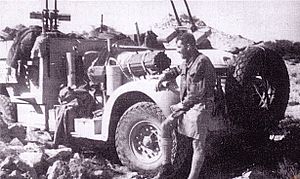
With the Eighth Army holding the El Alamein line, plans were made to attack Axis supply lines and ports. In September 1942, British Commandos would attack Tobruk. The SAS would attack Benghazi. The Sudan Defence Force would capture Jalo oasis. The LRDG would guide these attacking forces. At the same time, an LRDG force would attack Barce (Operation Caravan). The Barce force had 17 vehicles and 47 men from 'G1' and 'T1' Patrols. They had to travel 1155 miles to reach their target. 'T1' Patrol attacked the airfield, and 'G1' attacked the Barce barracks. An Italian prisoner of war said 35 aircraft were destroyed at the airfield. Official Italian numbers say 16 aircraft were destroyed and seven damaged.
On September 30, 1942, the LRDG stopped being under the Eighth Army. They reported directly to GHQ Middle East. The LRDG's last operation in North Africa was in Tunisia. During the Mareth Offensive in March 1943, they guided the 2nd New Zealand Division around the Mareth Line.
After North Africa

In May 1943, the LRDG went to Lebanon to train for mountain warfare. But after Italy surrendered in 1943, they were sent to Leros, one of the Dodecanese islands. There, they fought as regular infantry. They took part in the Battle of Leros. Their commanding officer, John Richard Easonsmith, was killed. David Lloyd Owen took his place. After this battle, the last New Zealanders left the LRDG and went back to their own division.
In December 1943, the LRDG was reorganized into two squadrons of eight patrols. Each patrol had one officer and 10 other soldiers. Patrols were parachuted north of Rome to get information about German troop movements. They also raided the Dalmatian Islands and Corfu.
In August 1944, British Squadron patrols were parachuted into Yugoslavia. One patrol destroyed two 40-foot sections of a large railway bridge. This caused big problems for German troops and supplies. The commanding officer, Lieutenant-Colonel Owen, and 36 men were parachuted into Albania in September 1944. Their mission was to follow the German retreat. They also helped Albanian resistance groups attack the Germans. In October 1944, two British Squadron patrols were parachuted into Greece. They mined a road used by the retreating Germans. They destroyed three vehicles and blocked the road. They fired on the trapped convoy from a hillside and directed RAF planes to destroy the rest of the convoy.
After the war in Europe ended, the LRDG leaders asked to be sent to the Far East. They wanted to fight against the Japanese Empire. But their request was turned down. The LRDG was officially ended in August 1945.
LRDG's Lasting Impact
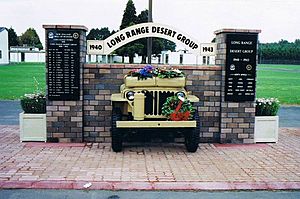
The Long Range Desert Group was ended when the Second World War finished. Today, the only similar British Army units are the Mobility troops of the Special Air Service. These troops are experts in using vehicles. They are highly trained in fixing any vehicle problem. They are also experts in desert warfare, just like the LRDG.
The Special Air Service Association represents the Long Range Desert Group. This group also represents other wartime units like the SAS regiments and the Special Boat Service.
The New Zealand Army built a special memorial for the LRDG. It is at the New Zealand Special Air Service barracks in the Papakura Military Camp. On August 7, 2009, two boards with the names of every New Zealand soldier who served in the LRDG were revealed.
One of the LRDG's Chevrolet WB trucks is on display at the Imperial War Museum in London. The LRDG Association gave it to the museum. It was found in the Libyan desert in 1983 by David Lloyd Owen, who was a retired Major General and chairman of the Association. It is kept in the same condition it was found in, rusted but mostly whole.
As of 2022, only one member of the group, Jack Mann, is still alive.
Notable Personnel
- Ronald Joseph Moore, who led the "Moore's March" of LRDG survivors through the Libyan desert.
LRDG in Popular Culture
- Sea of Sand (1958). A film about an LRDG patrol mission behind enemy lines.
- Play Dirty (1969). A film partly based on the LRDG's actions, showing a raid on an enemy base.
- Gli scorpioni del deserto (1969–92). A comic book series by Hugo Pratt and others.
- Killing Rommel (2008). A historical fiction novel by Steven Pressfield about the LRDG.
- Lost in Libya – In Search of the Long Range Desert Group (2009). A TV documentary that follows three LRDG trucks left in the Libyan desert in 1941. It includes old film of the LRDG in action.


